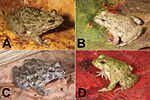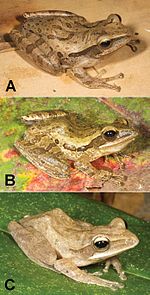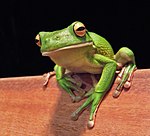Amphibians of Timor

That list includes the amphibians of Timor , the largest of the Lesser Sunda Islands in Southeast Asia . The island is divided into the Indonesian West Timor and the state of East Timor , which also includes the West Timor exclave Oe-Cusse Ambeno .
The only known amphibians of Timor are frogs . The most widespread are the black- scarred toad ( Bufo melanostictus ) that have immigrated from Southeast Asia in recent years , the representatives of the genus rice frogs ( Fejervarya ) belonging to the real frogs and of the row frogs the species Polypedates leucomystax . The three Fejervarya variants that have been discovered are not previously described species that are similar to Fejervarya verruculosa from the island of Wetar . Earlier reports of Fejervarya verruculosa , Fejervarya cancrivora or Fejervarya limnocharis in Timor are therefore regarded by the authors of the research report as incorrect identifications. Moreover, it was to be the Australian tree frogs belonging Everett tree frog and the only native species of its genus to Timor frog ( Limnonectes timorensis evidence). The IUCN Red List , which presumably are based on older research in West Timor, also tell of the giant tree frog ( Litoria Infrafrenata ), the Red tree frog (family Hylidae ) and Rana elberti .
In 2008 and 2009 there were reports that the cane toad ( Bufo marinus ) had been introduced to East Timor from Australia. These specimens, known by the population as the INTERFET frog ( Manduku Interfet ), have so far been identified as black- scarred toads .
Compared to other, larger islands in the Malay Archipelago , the amphibian fauna of Timor is relatively poor in species. Zoogeographically , the low diversity of amphibians can be interpreted via the relatively remote location of Timor within the Malay Archipelago - the settlement of this area took place over the land bridge of the Malay Peninsula , from which Timor is particularly far away.
So far, no amphibians have been detected on the island of Atauro , which belongs to East Timor .
| Amphibians on Timor | ||||
|---|---|---|---|---|
| image | German name | Scientific name | Name on Tetum | information |
 |
Three so far not described species of the tree frog genus | Fejervarya sp. | Manduku natar ( rice field frog ) | Previously incorrectly identified as Fejervarya cancrivora , Fejervarya verruculosa or Fejervarya limnocharis . Image description: A Fejervarya sp. 1 from Baucau (SVL 58 mm), B Fejervarya sp. 2 from Viqueque (SVL 46 mm), C Fejervarya sp. 3 from Viqueque (SVL 38 mm), D All three species that live in East Timor vary in the shades of green on the back and on the side. This specimen (SVL 56 mm) from Viqueque has the most extreme green coloration of the animals found in 2009, both in terms of appearance and colored surface. Rice frogs can be found in all communities in East Timor except Ainaro. |
| Timor bullfrog | Kaloula sp. | Manduku lakeru ( pumpkin frog ) | 2011 newly discovered species from Fatucahi ( Manufahi ) and Nancuro (Manatuto), previously incorrectly identified as the Javanese bullfrog ( Kaloula baleata ). | |
 |
Black-scarred toad | Bufo melanostictus , Duttaphyrnus melanostictus | Manduku Interfet ( INTERFET -Frog ) | Was initially confused with the cane toad . Proven in eleven of the 13 municipalities of East Timor. The black-scarred toad is missing in East Timor only in Lautém and Ainaro . |
 |
Timor Frog | Limnonectes timorensis | Manduku mota ( river frog ) | So far, the Timor Frog is known from two localities. One is on the Meleotegi river , near Eraulo (municipality of Ermera), the second in the rice fields of Afaloicai (municipality of Baucau). There are 130 km between the places. In contrast to the other representatives of its genus, the Timor Frog does not have a rough, warty skin, but rather a very soft skin with only a few warts on the side of the body. He has big eyes and strong hind legs with long toes. In some specimens an infestation of the leg muscles with tapeworms ( Cestoda ) was found. The Timor Frog is possibly identical to the more widespread Rana elberti ( Hylarana elberti ). There is also a general discussion about an assignment of the Timor Frog to the Ranidae . |
 |
Whitebeard rowing frog | Polypedates leucomystax | Manduku ai-riskadu ( Striped Tree Frog ) | In all municipalities except Aileu . |
 |
Everett tree frog | Litoria everetti | Manduku ai Timor ( Timor Tree Frog ) | So far only known from the Meleotegi river in the municipality of Ermera . |
 |
New Guinea giant tree frog | Nyctimystes infrafrenatus | Possibly only in West Timor. | |
| Red tree frog | Litoria rubella | No information is known about the population on Timor. Possibly only in West Timor. | ||
See also
Web links
- Hinrich Kaiser u. a., PhD: The herpetofauna of Timor-Leste: a first report. Department of Biology, Victor Valley College
- Hinrich Kaiser u. a .: First Update to Herpetofaunal Records from Timor-Leste. (PDF; 1.7 MB) In: Asian Herpetological Research. 2012, 3 (2), pp. 114–126.
- Caitlin Sanchez et al. a .: First report on the herpetofauna of the Oecusse District, an exclave of Timor-Leste In: Herpetology Notes , volume 5: 137–149 (2012)
- Mark O'Shea et al. a .: Herpetological Diversity of Timor-Leste Updates and a Review of species distributions In: Asian Herpetological Research. 2015, 6 (2): 73-131.
Individual evidence
- ↑ a b c d e f Hinrich Kaiser u. a., PhD, Department of Biology, Victor Valley College: The herpetofauna of Timor-Leste: a first report
- ↑ Wikinews, September 12, 2008, Toad Plague does not originate in Australia?
- ↑ ABCnews, December 17, 2009, Fears cane toads have hitched to E Timor
- ↑ a b c d e f g h i j k Mark O'Shea u. a .: Herpetological Diversity of Timor-Leste Updates and a Review of species distributions. In: Asian Herpetological Research. 2015, 6 (2): pp. 73-131., Accessed on July 17, 2015.
- ↑ The IUCN Red List of Threatened Species: Kaloula baleata
- ^ Government of Timor-Leste, November 28, 2010, Prime Minister officially launches the new stamp models for Timor-Leste
- ↑ The IUCN Red List of Threatened Species: Hylarana elberti
- ↑ The IUCN Red List of Threatened Species: Nyctimystes infrafrenatus
- ↑ The IUCN Red List of Threatened Species: Litoria rubella